- European Discovery
- Pre-cinchona treatments
- Importance of bark
- Quinine
- Experimentation
- Cultivation
- Ledgeriana
- Harvesting
- Quinine in Recent History
- Bibliography
- Disclaimer
The cinchona - a large shrub or small tree - is indigenous to South America. In the 19th century it could be found along the west coast from Venezuela in the north to Bolivia in the south. Its bark, also known as Peruvian Bark or Jesuit’s Bark, is renowned for its medicinal properties. It produces a number of alkaloids, namely cinchonine, cinchonidine, quinine, quinidine and quinamine. By far the most valuable of these is quinine, a drug used to treat malaria, which according to a report of the Commissions of Medical Officers of the Government in India, possesses “more than any other that can be named, the confidence of medical practitioners [in India]”. All the alkaloids, with the exception of sulphate of cinchonine, are known for their febrifugal properties. As a result of the popularity of quinine, however, these have, according to T.C. Owen in his Cinchona planter’s manual, fallen “into unmerited neglect".
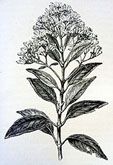
Cinchona Chahuarguera
(From Howard's Nueva Quinologia de Pavon) in Markam's Peruvian Bark
European Discovery
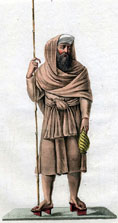
Jesuit missionary,
painting from 1779
(Wikipedia)
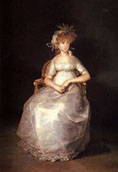
The Condesa de Cinchón
by Francis Goya
(Wikipedia)
Cinchona is believed to derive its name from the Countess of Chinchon, wife of a Spanish Viceroy of Peru. After contracting “an attack of fever” whilst visiting Peru in 1630, the Countess is alleged to have been cured by the cinchona bark. The more usual spelling ‘cinchona’, without the initial 'h' being the result of an early error. Clements Robert Markham, leader of the British expedition to South America, in 1860, was a great proponent of trying to re-establish the name “chinchona” which he believed to be correct. According to Poser and Bruyn in their An illustrated history of malaria, however, this story has, in recent years, been almost completely rejected owing to the research of Jospeh Rompel, Rubem Vargas Ugarte, Alec Haggis and Jaime Jaramillo-Arango.
Though there is some confusion over how cinchona bark first entered Europe what is clear is that the Jesuit missionaries were aware of its potential from a very early stage. According to the online Catholic Encyclopaedia they had “learned the healing power of the bark from natives during the years 1620-1630” and, according to Poser and Bruyn, it was being used in Jesuit colleges in Genoa, Lyon, Louvain and Ratisbon from 1650.
Pre-cinchona treatments
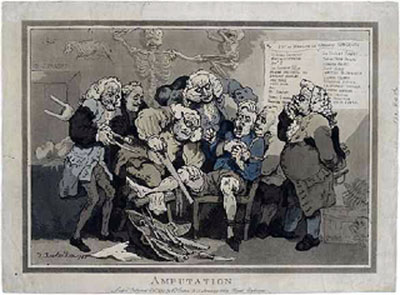
The Amputation - Thomas Rowlandson (1756-1827)
Until the appearance of cinchona in Europe during the mid 17th century medical practitioners treated victims of fevers, and malaria in particular, using primitive methods such as limb amputation, purging, blood-letting, the administration of herbs, rest, massage, hydrotherapy and a controlled diet. More unconventional methods included the wearing of amulets, the application of split pickled herrings to the feet, placing the fourth book of the Iliad under a patient’s head, throwing a patient head first into a bush in the hope he would get out quickly enough to leave his fever behind and “the embrace of a bald-headed Brahmin widow at dawn” (Poser and Bruyn). Some of these more eccentric methods, such as the use of spiders and their webs, were even endorsed by respectable gentlemen. As late as 1886 Dr. J. Donaldson wrote in the November issue of the Indian Medical Gazette that he found “orally administered cobwebs of greater value than quinine”.
Importance of bark

RCS/Y303E/45
Photograph collection of
John Abercromby Alexander
According to Kew, from the 17th century to the 1940s cinchona bark and its derived quinine alkaloids were the most effective treatment for malaria. Initially the bark, which was stripped from the tree, was dried, crushed into small pieces and turned into various tinctures. In England, Robert Talbor, a man from a prominent Cambridge family, is credited with the “elaboration and spread of cinchona bark therapy” (Poser and Bruyn). Talbor was the physician of Charles II and later that of Louis XIV and the Queen of Spain under the name of Talbot. Despite “the promptness of its effect and its infallibility” which “made it suspect for such a long time”, according to Ignace Vincent Voullonne writing in the early 18th century, cinchona bark “finally triumphed over the multiple reproaches that were heaped upon it … by ignorance, prejudice, the arrogance of sects [and] the hatred of the parties.” The use of this “Popish powder” had elicited considerable religious prejudice because of its association with the Jesuits. As demand grew, however, lack of experience of the bark, uneven consignments, incorrect identification, and the frequent and deliberate pollution of the product by adding the bark of other trees, all ensured the argument over its value was kept alive well into the 19th century.
Quinine
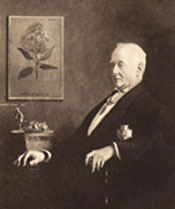
Portrait of Sir Clements Markham KCB FRS (1830-1916)
President of the Royal Geographical Society 1893-1905
by George Henry (1858–1943)
© Royal Geographical Society with IBG
Powdered cinchona bark “administered in various forms and in various vehicles remained the main anti-malarial agent until 1820” (Poser and Bruyn) in which year, according to Kew, the first quinine alkaloids were extracted and described by Pierre Pelletier and Joseph Caventou. By 1825 these had become the standard treatment for malaria. Indeed “cinchona bark and its derived quinine alkaloids” were “taking on an increasingly important role in the occupation and safe administration of tropical colonies” (Kew). As early as 1768 cinchona bark was being used as a prophylactic with James Lind, a British naval surgeon in the services of King George III, recommending that as long as a ship lay at anchor in a tropical port “every man receive a daily ration of cinchona powder”. This was a practice continued by Alexander Bryson, later Director General of the British Naval Medical Service, when quinine replaced cinchona powder (Poser and Bruyn). Increased demand led to problems in supply. Trees were being felled in indigenous regions, prices rising and supplies diminishing. Thus in 1852 a Dutch expedition, followed by a British expedition in 1860 led by Sir Clements Markham, was sent to South America in order to procure cinchona seeds and plants which could be established on plantations in the colonies. Transportation of these seeds and saplings posed its own difficulties. In the Cinchona planter’s manual, for example, Owen describes how on flat land “bridges are often necessary for crossing ravines.”
 |
| Taken from Return to an address of the honourable the House of Commons, dated 3 May 1870;-- for "copy of all correspondence between the Secretary of State for India and the Governor General, and the governors of Madras and Bombay, relating to the cultivation of chinchona plants, from April 1866 to April 1870." |
Experimentation
In the early days of cultivation experiments were made in various countries within the British Empire - in India, Burma, Ceylon, Malaya, the Sudan, St. Helena, Jamaica, Trinidad, Mauritius, Australia and New Zealand - but these were not always pursued to a definite conclusion (Cowan). Outside the British Empire the tree was introduced into Java, West and East Africa, St. Helena, West Indies, Fiji, Madagascar, Reunion, Mexico, Central America, Columbia and Bolivia. With the exception of Java, India and Ceylon, however, cultivation never “added appreciably to the world’s supply of the bark” (Bulletin of the Imperial Institute).
Cultivation

Cinchona plants at Ootacamund, August 1861
From Travels in Peru and India,
C.R. Markham, 1862
Reproduced in Geographical Journal
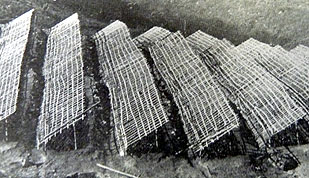
A chinchona nursery on Munsong Plantation
(Empire Forestry Journal v.8, no.1)
Cinchona did not prove the easiest plant to grow. Medicinal species cannot stand frost, trees prefer a cool climate with little contrast between summer and winter and day and night temperatures, and do not like stagnant moisture at their roots or direct sunlight. In consequence they cannot grow on flat land and prefer a rich soil (Watt). In Madras seed beds were protected by “light pandals” of fern simply stuck in the ground, sufficiently thick to shade the soil. The plant also has an “extraordinary habit of sporting or hybridizing” a peculiarity which is “most marked in the finest species” (Owen). Furthermore, of the 65 species of the genus Cinchona of the Index Kewensis, referred to in Cowan’s article of 1929, only three are noted as giving off a sufficient percentage of alkaloid to be worth cultivating.
Ledgeriana
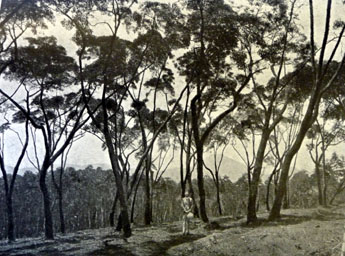
Original Ledgeriana Trees,
60 years old
(Malayan Agricultural Journal v.19)
Unfortunately the early species exported from South America were found to possess low percentages of quinine. The percentage could vary not only from species to species and from plantation to plantation but different quantities could be extracted from the bark on different sides of the same tree. However, with yields generally as low as 1.5% production did not, therefore, promise to be an economic success. This changed when in 1865 “seeds of quinine plants were smuggled out of South America by Charles Ledger … for a fee of about 20 dollars (about the cost of Manhattan Island!)” that contained a surprisingly high quinine content, ranging from 8-13.25%. This variety became known as the Cinchona Calisaya Ledgeriana and its export ultimately “destroyed the South American monopoly on quinine”. Manuel Mamani, who was Ledger’s servant and had helped him to obtain the seeds, was “jailed, beaten, and eventually starved to death for his participation in the scheme.” (http://www.botgard.ucla.edu)
Harvesting
According to Owen, there are four methods of harvesting the bark - stripping and renewing, scraping, coppicing and uprooting. The complete uprootal of trees and the collection of the whole bark from root, trunk and branches being the method deployed in South America leading to such a depletion of resources there. In 1863, however, Mr McIver discovered that, “if a portion of the bark of a living cinchona be carefully removed so as not to injure the young wood of the tree the removed bark will, provided certain precautions are taken, gradually be renewed.” (Watt). Furthermore this renewed bark proved richer in alkaloids than the original, particularly if excluded from light whilst growing. Watt provides a useful description of this method in which “the barker with the sharpened point of an ordinary pruning knife, makes several cuts running down the stem parallel to each other, about an inch apart, and then with the blunt back of his knife, he raises every alternate narrow strip and removes it from the tree”. If successfully executed, without damaging the layer of cambium cells, which lies between the bark and wood of the tree, “a new layer of bark will be formed in the place of that which has been taken away”. After 3 years the strips left on the tree can be removed and the process repeated every 3 years until the tree dies or is too old to regrow its bark sufficiently. Owen writes in his Cinchona planter’s manual that this is “work which requires constant European supervision.”
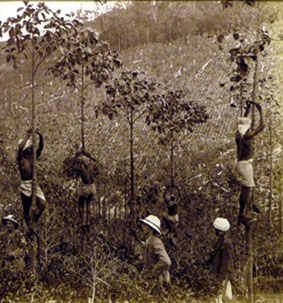 |
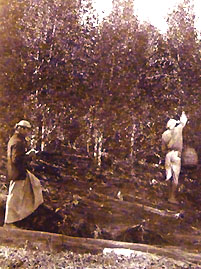 |
 |
| RCS/Y303E/47 Photograph collection of John Abercromby Alexander |
RCS/Y303E/46 Photograph collection of John Abercromby Alexander |
RCS/Y303E/46 Photograph collection of John Abercromby Alexander |
The Dutch Monopoly
Following the introduction of Ledgeriana cinchona plantations began to attract private enterprises particularly as the Netherlands East Indian Government were prepared to supply free seeds and cuttings. By the 1890s production was considerably in excess of demand, not helped by the Remija species being discovered in northern parts of Africa. During this time whilst Java planters concentrated on lowering the cost of production and improving the cultivation of cinchona to withstand the depression (Kerboesch) in Ceylon, at least, cinchona was “everywhere being uprooted to make way for tea” (Dr. King). Tea giving a more certain return and being easier to cultivate.
 |
| From Bulletin of the Imperial Institue, v.16 (1918) |
Furthermore, in 1913 an agreement was drawn up between the Javan cinchona producers and the manufacturers of quinine in Java, England, Holland and Germany to put an end to the “great variation in price which jeopardised the security of the bark producers.” (Kerboesch) This resulted in a situation where “for many years past the Netherlands East India Cinchona plantations have produced 97% of total world production while British India has produced 2.5% and the rest of the world 0.5%. This situation is confirmed by Cowan, when he states that “India, the only cinchona producing country of consequence other than Java makes no attempt to supply the needs of other parts of the Empire”, in fact, “she, in common with the rest of the world, looks to the Dutch Plantations in Java to aid her in her misfortune.” Writing in 1929, Cowan goes on to say that, according to Dr. Balfour, the “direct loss sustained by the British Empire due to sickness and death caused by malaria is said … to amount to between £52,000,000 and £62,000,000 each year. Whilst, in practice, the production of quinine “took into account the law of supply and demand” “millions of sufferers are [and continue to be] so poor that they would be unable to purchase quinine at even the approximate cost of production.” A situation which, in 1931, Kerboesch was already calling for the League of Nations to assess.
Quinine in Recent History
Already by the early 20th century quinine was proving ineffective in treating some patients. It was also seen to have a number of unpleasant side-effects, if consumed in quantity including nausea and tinnitus (Kew). After the outbreak of World War II supplies of the drug became, in any case, inaccessible to the Allies as “the world supply of cultivated quinine trees in Asia (especially in Indonesia and Java) was captured by Japan” and quinine reserves in Amsterdam were captured by Germany (http://www.botgard.ucla.edu). Thus research into synthetic antimalarials such as Atrabine and Chloroquine were encouraged. Despite the foundation of research committees in both the US and the UK specifically for the purpose of producing synthetic antimalarials though, Poser and Bruyn argue that, “the process proved too expensive and complicated for commercial exploitation”. Although synthetic antimalarials have been developed much further in recent years, according to the WHO [link] in 2006 over 247 million people were affected by malaria and of those almost 1 million died. Indeed a child is reported to die of malaria every 30 seconds. It is perhaps no surprise then that the WHO recommended in 2004 that “all countries facing shortages increase procurement of their second-line antimalarial treatment, which is generally quinine” and that David Greenwood stated in 1999 that “the century that started by relying on the bark of a tree to treat malaria may end by returning to a natural product.”
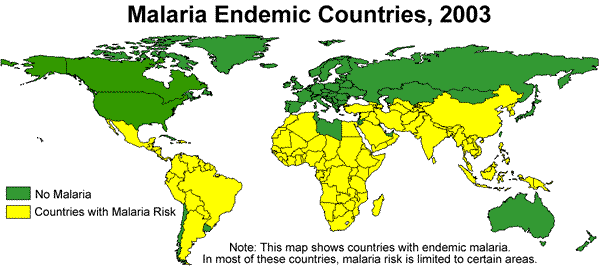 |
| Malaria geographic distribution (Wikipedia) |
Bibliography
Monographs:
T.N. Christie: Prize Essay on Cinchona Cultivation (Colombo: A.M.&J. Ferguson, 1883)
A.H. Markham: The Life of Sir Clements R. Markham (London: John Murray, 1917)
C.R. Markham: Peruvian Bark (London: John Murray, 1880)
T.C. Owen: The Chinchona Planter's Manual (Colombo: A.M.&J. Ferguson, 1881)
C.M. Poser and G.W. Bruyn: An Illustrated History of Malaria (New York: Parthenon, 1999)
G. Watt: Dictionary of the Economic Products of India, v.2 Cabbage to Cyperus (Calcutta: Printed by the Superintendent of Govt. Printing, India, 1889)
Journals:
J. M. Cowen: Cinchona in the Empire. Progress and prospects of its cultivation in Empire Forestry Journal, v.8, no. 1 (July 1929) pp.45-53
D. Williams Clements Robert Markham and the Introduction of the Cinchona Tree into British India, 1861 in The Geographical Journal, v.128, pt.4 (1962) pp.431-442
Cinchona Culture in Java in The Malayan Agricultural Journal v.19 (1931) pp.267-268 and 291-296
The Future of the Trade in Cinchona Bark in Bulletin of the Imperial Institute, v.16 (1918) pp.370-388
Websites:
http://www.kew.org/collections/ecbot/collections/topic/cinchona/index.html
http://www.botgard.ucla.edu
http://www.who.int/mediacentre/factsheets/fs094/en/
http://www.who.int/mediacentre/news/releases/2004/pr77/en/
http://www.newadvent.org/cathen/08372b.htm
https://www.countway.harvard.edu/chm/rarebooks/exhibits/satires/page_2.html
http://images.rgs.org/ Includes images of Markham and cinchona
Electronic resources:
http://parlipapers.chadwyck.co.uk/home.do
- 1863 (118) Return to an address of the Honourable the House of Commons, dated 9 March 1863; -- for, "copy of correspondence relating to the introduction of the chinchona plant into India, and to proceedings connected with its cultivation, from March 1952 to March 1863."
- 1866 (353) Return to an address of the Honourable the House of Commons, dated 14 March 1866; -- for, "copy of correspondence relating to the introduction of the chinchona plant into India, and to proceedings connected with its cultivation, from April 1863 to April 1866."
- 1870 (432) Return to an address of the Honourable the House of Commons, dated 3 May 1870; -- for "copy of all correspondence between the Secretary of State for India and the Governor General, and the governors of Madras and Bombay, relating to the cultivation of chinchona plants, from April 1866 to April 1870."
- 1876 (120) Return to an address of the Honourable the House of Commons, dated 8 July 1875; -- for copies of the chinchona correspondence (in continuation of return of 1870) from August 1870 to July 1875."
- 1877 (279) Further return to an address of the Honourable the House of Commons, dated 8 July 1875; -- for copies of the chinchona correspondence (in continuation of return of 1870) from August 1870 to July 1875."
Disclaimer
We cannot absolutely guarantee that we have not unwittingly and despite our best endeavours infringed someone's copyright. In the event that such an infringement is brought to our notice, we will remove the image or images from this web site within 3 days of notification. We further welcome any information that might help us make proper attributions, identify copyright owners, or correct copyright acknowledgements as the origins of our collections are sometimes obscure.
